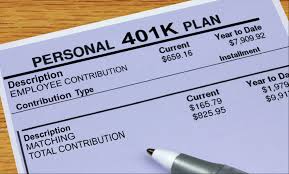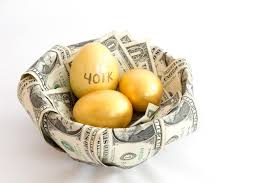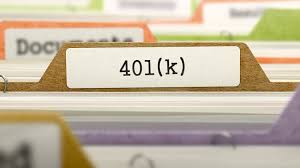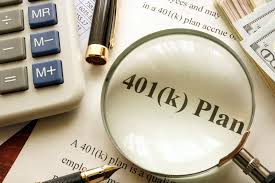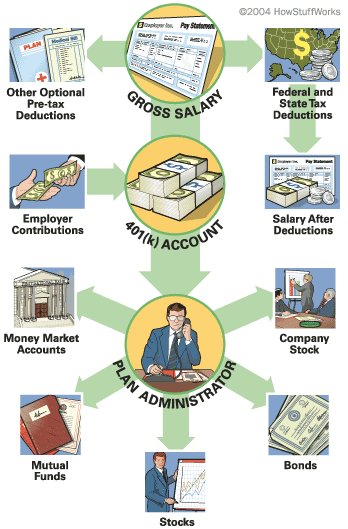Prestige Professional Management
Your Consumer Resource Specialist
When people talk about 401(k) plans, you often hear about advantages like:
- Free money from your employer
- Lower taxable income
- Savings and earnings that accumulate without you having to remember to make deposits
- The opportunity to retire and not have to worry about money anymore
Does this sound too good to be true? It isn't. It's what you can gain from investing in your company's 401(k) plan. The 401(k) is one of the most popular retirement plans around.
Although retirement plans may be the farthest thing from your mind, think about how much of a difference 10 years can make in the investing world. You'll learn about that difference in this article. If your employer offers a 401(k) plan, it makes a lot of sense to participate in it as soon as possible. If you start early, maybe when you're 25 or so, you can very likely have a million or two (or more) in your account by the time you retire.
In this article, you will find out how small monthly investments can turn into a million dollars by the time you retire. You'll find out why the 401(k) plan is one of the best ways to save for retirement, why your employer offers it, and how you can make the most of your account.
In 1978, Congress decided that Americans needed a bit of encouragement to save more money for retirement. They thought that if they gave people a way to save for retirement while at the same time lowering their state and federal taxes, they might just take advantage of it. The Tax Reform Act was passed. Part of it authorized the creation of a tax-deferred savings plan for employees. The plan got its name from its section number and paragraph in the Internal Revenue Code -- section 401, paragraph (k).
Ted Benna, who was a benefits consultant, actually came up with the first version of this plan. His plan was officially accepted by the IRS and proposed regulations were issued in 1981. In 1982, taxpayers were able to take advantage of this new plan for the first time. It took almost 10 years, but final regulations were eventually published in 1991.
401(k) plans are part of a family of retirement plans known as defined contribution plans. Other defined contribution plans include profit sharing plans, IRAs and Simple IRAs, SEPs, and money purchase plans. They are called "defined contribution plans" because the amount that is contributed is defined either by the employee (a.k.a. the participant) or the employer.
What makes a 401(k) different?
Four things differentiate a 401(k) plan from other retirement plans. When you participate in a 401(k) plan, you tell your employer how much money you want to go into the account. You can usually put up to 15 percent of your salary into the account each month, but the employer has the right to limit that amount. It might be worth your while to rally for a higher limit if it isn't as high as you would like it to be. The IRS limits your total annual contribution to $15,000 (for 2006).
The money you contribute comes out of your check before taxes are calculated, and more importantly, before you ever have a chance to get your hands on it. That makes the 401(k) one of the most painless ways to save for retirement.
If you're lucky, your employer will match a portion of your contribution. Your employer wants you to participate in the plan because of compliance issues we'll talk about later. The matched amount they offer (the free money part) is your incentive to participate.
The money is given to a third party administrator who invests it in mutual funds, bonds, money market accounts, etc. They don't determine the mix of investments -- you do that. They usually have a list of investment vehicles you can choose from as well as some guidelines for the level of risk you are willing to take. We'll also talk about that later.
Here's what the overall process looks like:
The drawback to the 401(k)?
If you withdraw your money before you are 59.5 years old, you'll have to pay the tax on it, PLUS a 10% penalty fine to the IRS.
How safe is your money?
What if your employer declares bankruptcy? How do you know your money is safe? The Employment Retirement Income Security Act (ERISA) that was passed in 1974 includes regulations that protect your retirement income. It requires that all 401(k) deposits be held in custodial accounts in order to keep your money safe in the event that something happens to your employer.
It also sets requirements that your employer must follow, such as sending you regular account statements, providing easy access to your account, and maintaining compliance so that the plan is fair for everyone in the company. It also requires your employer to provide you with educational materials about the investment opportunities within your plan.
401(k) vs. Stocks
Why would you be better off contributing to a 401(k) plan than you would be, say, investing in stocks on your own? After all, with your own investments at least you're not penalized when you sell them. There are several advantages to a 401(k) over your own investments. Of course, that doesn't mean you shouldn't do both. It is always a smart move to diversify (or spread out) your overall financial investments. The primary advantages to a 401(k) are that the money is contributed before it is taxed and your employer may be matching your contribution with company money. There are other advantages, but let's talk about the two heavy hitters first.
What does "pre-tax" really mean?
Let's do the math to see the advantage of pre-tax saving. For example, you may decide you want to put $200 into your account each month. Assume that, prior to starting your 401(k), you were bringing home $2,000 per month pre-tax, and $1,440 post-tax (paying $560 in tax for a 28-percent tax bracket). Because the $200 comes out pre-tax, that means you are taxed on $1,800 (paying $504 in tax), so your post-tax income is $1,296. In other words, you are paying $200 into your 401(k), but your take-home pay only goes down by $144. You just saved $56 per month!
In addition to reducing the amount of tax you pay on your salary, you'll also defer tax on earnings from your 401(k)'s investments until retirement. At that point, you will probably be in a lower tax bracket anyway. You may also be living in a state that has no state income tax. (FYI, those states are: Alaska, Florida, Nevada, South Dakota, Texas, Washington, and Wyoming. Tennessee and New Hampshire only tax dividends and interest income.) It may not seem like a big deal now, but try out this Taxed and Non-taxed Compounding Calculator to see how much this can make a difference over the years.
Free money?
Let's talk about that free money from your employer. Although they aren't required to, many employers match a percentage of what their employees contribute to their 401(k) accounts. The catch is, they typically don't put anything in unless you do. (We'll talk about "Safe Harbor" options later -- these can require your employer to contribute to every eligible employee.) If you aren't participating in the program, you're basically leaving money lying around for someone else to pick up. It's like finding a $20 bill at the amusement park and leaving it lying on the ground.
Another thing to remember about the contributions your employer makes is that, although the total annual amount they can contribute is limited by the IRS, that amount doesn't count toward the total annual amount you can contribute ($15,000 in 2006).
There is an overall limit on how much can go into your 401(k) account each year. The total for 2006 is $44,000 or 100 percent of your annual salary, whichever is less. This limit is referred to as the 415 limit (also named after the Internal Revenue Code that established it).
A small downside to the employer contribution is that there may be a vesting schedule. Vesting means that there is usually a tiered schedule for when money the employer contributes to your account is actually yours. For example, your employer may have a three-year vesting schedule that increases your ownership of the money by one-third each year. After three years, the money is all yours and
all future contributions are 100-percent
Borrowing From Your Account
You may be thinking that you really can't afford to put 15 percent of your salary into an account you won't be able to touch until you retire. But in some 401(k) plans, you can borrow from your account in the event of an emergency. You'll pay interest, but you are paying it to yourself. (There can be some disadvantages that go along with the advantages of taking out a loan against your 401(k).)
And finally, if you're thinking about just opening an IRA (which is still a smart thing to do), you might take note that you can only contribute $4,000 annually to an IRA (in 2006 -- this will increase to $5,000 by 2008), while your annual contribution to the 401(k) can be up to $11,000.
Changing jobs
What if you change jobs? Does that mean you have to pay the tax and penalty in order to keep your money?
No. You can either:
Keep your money in your former employer's plan
Roll the money over into a new 401(k) plan or IRA
You do have the option of cashing out, but unless you are 59.5 you will have to pay the tax and the 10-percent penalty to the IRS. If you decide to roll it over into another 401(k) or IRA, MAKE SURE you don't let the check be written to you. The check has to be written to go directly into the new account. There is no grace period for putting the money into the new account. If it does come to you rather than the new account, you'll be charged the tax and the 10-percent fine.
If you choose to keep your money in your former employer's plan, then there are also a couple of requirements. First, you have to have a fully vested total of at least $5,000 in your account, and second, you have to be under the plan's normal retirement age (usually 65).
How Much to Contribute
So, how much should you be putting into your 401(k) account? That partly depends on what your employer will let you contribute. Usually you can put in up to 15 percent of your annual salary. If your employer doesn't allow that much, then you can always lobby for a higher percentage. It may take a while and you'll need the support of co-workers, but it would be worth it. For 2006, the IRS limits the total annual contributions (both your contributions and the amount your employer matches) to 100 percent of your salary or $44,000,
whichever is less.
Things to consider...
There are several things to take into consideration before you settle on an amount to contribute each month. First, how is the economy right now? Is your job stable? Are there are lot of layoffs going on in your industry? If that's the case, then it would be prudent to have a little more money in a more accessible savings account or other financial account. The general rule of thumb is that you want to have at least three months of living expenses in an accessible account at all times, and preferably six months. This is particularly true in tougher economic times.
But, what if everything is going swimmingly, your job is secure, and you don't have any large upcoming financial needs (like kids going to college)? In that case, you should probably be a little more aggressive with your contributions. Plan out your needs for the year and make a commitment to yourself about how much money you want to save. It will all boil down to how much money you can realistically do without. Extravagant vacations, luxury cars... do you really need them? Or, it may just be a matter of how much money you can do without and still be able to pay all of your bills.
Whatever the situation, sit down and figure out a budget that includes a set amount of money going to a 401(k). There are some great budget calculators available on the Internet that will help make sure you don't miss anything when you set up your budget. Use this investment calculator to find out how much difference $50 per month will make over 20 years, or $100 will make over 10 years.
Overall, if you're young, have a secure job, and have no big money needs coming up, then it makes sense to put as much into your 401(k) account as your employer will allow you.
Don't forget raises...
The 401(k) plan is so easy that you may even forget you're putting money into it. Whatever you do, don't forget to increase the amount you put in when you get a pay raise (or even if you have more income from some other source). In some cases, your employer may be transferring your contribution as a percentage of your salary. If that's the case, then increases in your salary will automatically increase your 401(k) contribution. If your employer is putting a flat amount into your account, however, you'll need to make sure you tell your employer to increase it and by what amount.
Deciding Where to Invest
So far, all of this 401(k) decision-making has been pretty easy. Now it is time for the fun part -- deciding exactly how and where you want to invest your hard-earned dollars. Your typical 401(k) plan may offer 20 or more investment choices, including:
- Stock mutual funds
- Bond mutual funds
- Stable value accounts
- Money market accounts
What are the differences in these?
How you should split up your dollars to get the most bang? Most likely, your plan administrator won't be advising you on exactly where to invest. It's too much of a liability. First, let's go over what all of the options listed above actually are.
Money-market accounts and stable value accounts usually consist of certificates of deposit and U.S. Treasury securities. They are very secure, and offer small but steady growth.
Bond mutual funds are pooled amounts of money invested in bonds. Bonds are basically IOUs that companies or governments issue. Bonds are paid back with interest that is usually a fixed percentage of the amount purchased. When a bond within the mutual fund reaches maturity, the proceeds are used to purchase different bonds for the portfolio.
Stock mutual funds are portfolios of company stocks. When you buy stocks, you are buying a small part of the company. Stock mutual funds, like bond mutual funds, are managed by a professional money manager. Each company's stock within the portfolio has a different value that will fluctuate based on the company's business success. The mutual fund's share price is determined by its net asset value, which also fluctuates with the circumstances of the companies within the fund.
Risk Levels
The first important decision you have to make is what kind of risk you are willing to take. You can take the conservative route, which will mean lower returns but a lower chance of losses. Or, you can take a moderate route, which includes a mix of risky and conservative options and moderate-to-low returns. Or, you can be aggressive and go for options with high earning potential but also higher risks. As a fund's potential return increases, its level of risk increases. Risk is essentially the fluctuations that will be a part of any fund's existence. This means that the time frame in which you have to invest will greatly affect the plan of attack you decide on for your 401(k) investments.
For example, if you are going to need the money sooner than later, then your risk tolerance will be lower and you'll need to choose low-risk investments with a more consistent and stable history of returns. You can also lower your risk by diversifying your investments.
If you have many years of investing ahead of you (10 or more), then you can probably afford to take more risks. The longer you have your money invested, the longer you will have to recover from any losses.
Your own personal feelings toward investing are also a big factor. Stressing over investments is not good for anyone. Think about what risk you are comfortable with and then plan your investments accordingly. Remember that most plans let you rearrange or "rebalance" your funds at least quarterly, and in some cases you can rebalance as often as you want.
Making Your Selections
Of the choices you have, the riskiest, but also the option with the most earning potential, are stock mutual funds. Historically, stocks as a whole have had average annual returns of close to 11 percent. The tricky part is to select the right stock mutual funds. How do you know which are the best performing funds? According to an article by the Motley Fool, "Over time, the absolute best performing type of stock mutual funds, bar none" is an index fund. An index fund essentially matches the market. It has no manager and is simply made up of representative amounts of each stock in the index. It is the safest bet on achieving a steady rate of return that can come very close to or match that 11-percent average.
There are several index funds. The most well-known is probably the S&P 500 index. This index fund performs well, but there are also others that perform well -- such as the Wilshire 5000. Because it is very difficult to pick stocks individually that outperform an index like the S&P 500, it makes a lot of sense to invest in an index fund. The same article by the Motley Fool states that index funds outperform between 80 percent and 90 percent of actively managed equity funds.
The problem comes in when your 401(k) plan does not offer an index fund. What do you do then? Part of the boost in an index fund's value comes from the fact that is not actively managed, and therefore doesn't have the fee associated with that management. You can put together some funds that might act like an index fund, but it will take some work. The first things you have to look at are the fees and commissions that are charged. Look for a fund that has management fees less than 0.75 percent, no sales charges, and no 12b-1 fees. (12b-1 fees are annual fees that the fund uses for its marketing efforts.) You also want to look for a fund that has low turnover of stocks -- that typically means that it performs well. The fund's past performance is also a good indicator of future success, but is not a guarantee.
Doing Your Homework
Don't blindly choose stocks without knowing anything about them. Do a little homework. Your plan administrator should have information available for you about each fund. These are often available online as well. Read the prospectus of each fund and select the ones that you find fit best with your own philosophies and ideas.
Market Capitalization
Stock funds are usually categorized based on the size of the companies they invest in. This doesn't mean the size of the company exactly, but rather the stock market value. This is determined by multiplying the number of outstanding shares by the share price. This is called market capitalization, or cap size.
Small-cap funds typically invest in companies that have a market value less than $1 billion. Small-cap funds can provide high investment returns but are also considered to be a little risky.
Mid-cap funds are usually made up of companies valued in the $1 billion to $8 billion range. They'll have some in the lower end that are likely to have higher growth but at the same time add some risk.
Large-cap funds invest in companies with market values that are more than $8 billion. Large caps often follow the index funds and invest in all of the companies. Large-cap funds are less risky but typically
produce lower returns.
To build a diversified portfolio of funds, one strategy is to select 25 percent of funds from small-cap stocks, 25 percent from mid-cap stocks, 25 percent from large-cap stocks, and 25 percent from international stocks. If your 401(k) plan doesn't offer all of those options, then you can fill in the missing ones with an IRA. The idea is to spread out your investments to create a diverse portfolio. This helps balance out your risk because when you have one fund that is up, you'll probably have another fund that is down. The large-cap funds are less risky, but the small-cap funds often have more growth potential.
In order to keep this balance, you also need to remember to check back from time to time and make sure you still have the same percentages for each type of fund. If companies within a fund are doing extremely well, they can often be pushed to another level, in which case your investments become off-balance.
What to Watch Out For
Here are some things to watch out for:
Having a high percentage of your company's stock - Since the Enron debacle, many companies (and employees) are taking a look at their 401(k) offerings and evaluating the mix of outside stocks with company stock. It is not recommended to have more than 20 percent of your portfolio with one stock.
Some companies encourage employees to buy their stock and may even give the 401(k) matching amount in company stock rather than cash. This creates a very unbalanced portfolio for employees.
Missing out on some of the employer match because you don't contribute enough - For example, say your company matches 50 cents on the dollar up to five percent of your salary. That means that if you only contribute three percent of your salary, you're missing out on some of that free money.
Let's look at the numbers. If you earn $40,000 per year, that means contributing $1,200 (three percent) would mean your employer is only contributing (matching) $600 rather than the $1,000 they would be putting into your account if you were contributing the full five percent ($2,000). In this scenario, you are losing $400 per year in free money. That may not seem like such as terrible thing, until you look at what that single year's lost $400 would do in 20 years at an average stock earning of 10 percent -- that $400 would grow to $2,955.62.
Employers Benefit and Responsibility
Why would employers offer 401(k) plans? What's in it for them? There are actually several benefits for employers. For one thing, the job market often demands it. In order to get the best and brightest employees, companies have to offer attractive benefit programs. The 401(k) plan can, therefore, help in recruiting.
Employer contributions to the 401(k) plan can also be tied in with company profits and other corporate goals. In other words, it can act as an incentive plan to encourage employees to work harder and smarter in order for the company to do well. If company goals are met, then the employer contribution level may be higher.
The 401(k) plan is also less expensive than defined-benefit plans, which guarantee a specific (defined) amount be given to you when you retire. Also, the overhead and administrative costs of the 401(k) plan, as well as any matched contributions the employer makes, are tax-deductible expenses.
Remember also that employers have their own financial future at stake, so offering a good 401(k) plan for employees will benefit them as well.
When employers decide to offer a 401(k) plan to employees, there are several steps they have to go through, both initially and on an ongoing basis. The first thing they'll do is invite several different plan providers to submit proposals for their plans. Every plan provider will have administrative fees and other costs that can vary quite a bit from provider to provider. They will also have different levels of services that may or may not be free.
In order to get the best deal that will meet the needs of the company, employers have to first make sure they are comparing apples to apples by ensuring that all of the providers are giving them the same information. The U.S. Department of Labor's Employee Benefits Security Administration offers a uniform fee disclosure form that is available for download. By using this form, the employer can uniformly request information from plan providers. There are several aspects of each individual plan they also need to look at, including:
Features - This includes the number of investment options, the types of investments, the availability of Internet access and trading, and loan features.
Fees - How are the plan's fees are charged? For example, some fees can be charged directly to the overall plan, while others may be deducted from investment returns.
Services - What services does the plan offer? Which of those are free and which incur an additional charge?
Fee variations - What the fee variations for different types of investment options?
Restrictions - Are there rules against early termination of the plan with that provider?
Educational assistance - How much help is available for employees? Is that service free or is it offered for a fee?
Customer service - What kind of customer service will the employer receive? How can the plan be modified as the company's needs change?
Some of these items are optional things that the employer will have to decide about. For instance, there may be features of the plan that the employer doesn't want to make available. The employer then has to decide which of the fees will be paid by the company and which will be paid by employees.
The average 401(k) plan that includes matching contribution costs runs from 2% to 3% of payroll.
Regulatory Compliance Issues
In order to make sure that the plan is fair to all employees and not just the highly compensated employees (HCEs) or key employees, the IRS mandates that the plan satisfy nondiscrimination tests each year. These rules are just to make sure that employees have been made aware of the plan, are taking advantage of the plan, and are receiving equal benefit from the plan.
A plan that is "top heavy" has more than 60 percent of assets coming from key employees. Key employees are employees that are at least 5-percent owners of the company, earn more than $85,000, or had a salary that ranked in the top 20 percent of salaries within the company.
What it boils down to is that the non-highly compensated employees have to contribute at a rate that is proportionate to that of the highly compensated group. If lower-paid employees' contributions are lower than expected, then the highly compensated employees will be limited in how much they can contribute. This is partly why employers work so hard to get employees to participate in the 401(k) plan -- if those lower-paid employees don't contribute much, then the higher paid employees (such as executives and owners) can't contribute much, either.
If the plan is top heavy, then the employer has to work to correct the problem by either lowering the HCE's contribution limit or contributing more to the non-HCE's accounts. There is also a Safe Harbor option, which is simply another way of ensuring balance within the plan. The Safe Harbor method lets employers skip the nondiscrimination tests if they immediately fully vest employees and meet the following contribution requirements:
Every non-HCE receives a 100-percent match on contributions they make that are up to three percent of their total salaries, and a 50-percent match on contributions they make that are from three percent to five percent of their salaries.
The rate of matching contributions being made to HCEs cannot be higher than that made to non-HCEs.
As an alternative, an employer can make nonelective contributions equal to three percent of all eligible employees' salaries -- even those not participating in the plan.
Employers are required to submit Form 5500 annually to the IRS. This form provides reports and statistical information about the plan and its sponsors, and provides proof of compliance with the 401(k) legal requirements.
The 401K Retirement Plan
